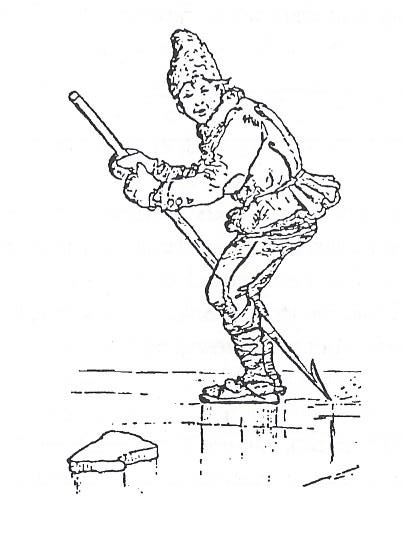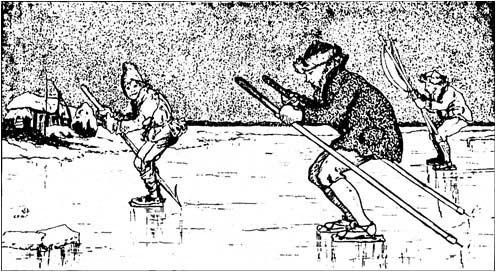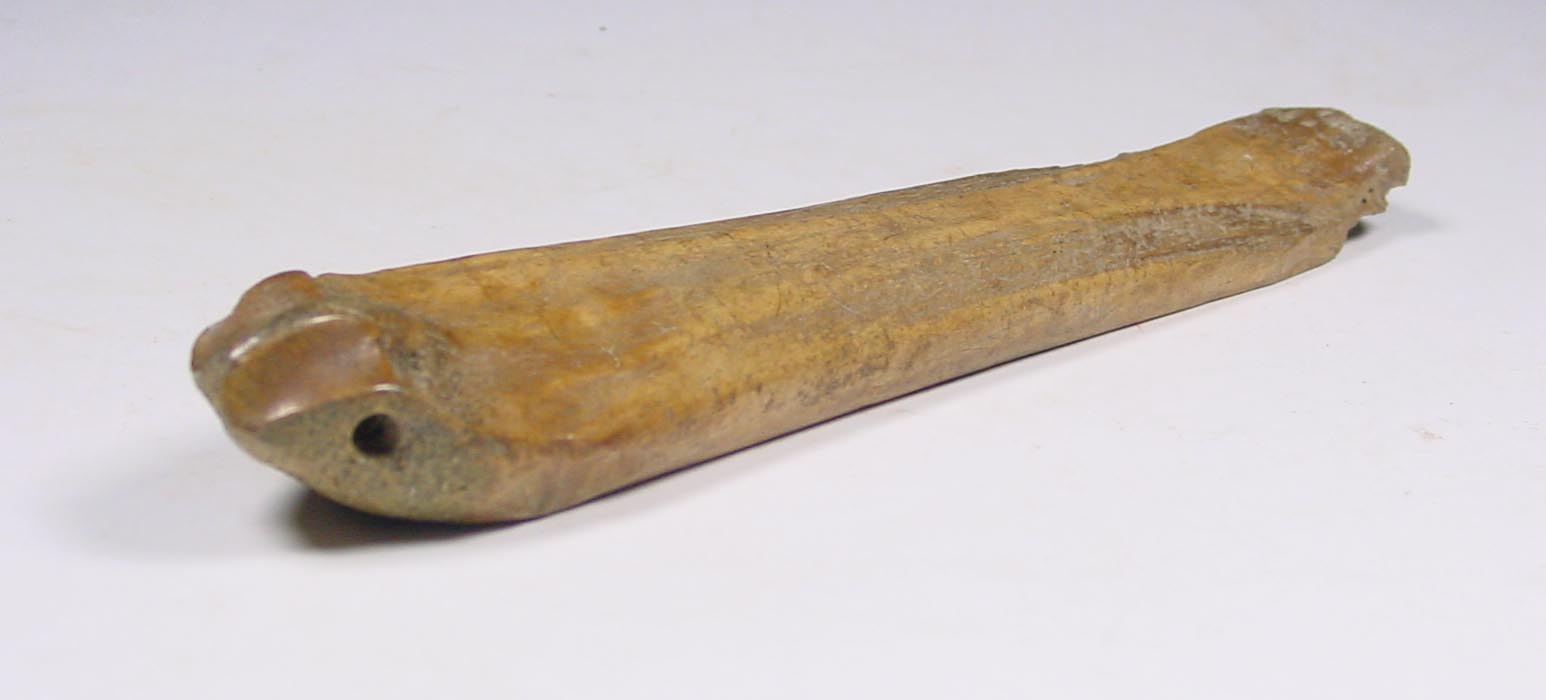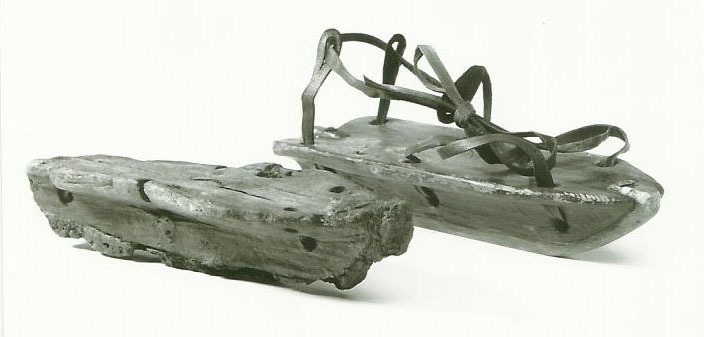The origin of skating
Author Wiebe Blauw, 2001
Translation Cheryl Richardson, 2018
During the first millennium the Netherlands was inhabited by various agriculturally based tribes. These semi-nomadic communities provided the necessities of life by growing grain, keeping cattle or hunting game. Bartering was practiced to a small extent. The range of these residents was small, especially if the weather conditions were poor and the paths, impassable. In these cases, the presence of ice in the winter opened opportunities to bridge distances. It was easier to walk over frozen land than swampy lowlands. In addition it was possible to cross canals, rivers and lakes without a vessel.
From roughly the beginning of this era, people in the Netherlands slid over ice on bone runners. They pushed themselves with a prod because a sideways grip with the blunt side of a bone was not possible. Nevertheless, these bone runners can be seen as the precursor of the modern skate.
'Skating' on bone runners

 By using bone runners on the ice, the bottom was further ground through wear. Since bone contains a lot of fat, ice and water didn’t usually stick to it. But if the skater was not satisfied with the water-repellent ability of his bone runners, he could rub the bone with animal fat, in particular pork fat.
By using bone runners on the ice, the bottom was further ground through wear. Since bone contains a lot of fat, ice and water didn’t usually stick to it. But if the skater was not satisfied with the water-repellent ability of his bone runners, he could rub the bone with animal fat, in particular pork fat.
The ice prods used consisted of a wooden stick with a point that went into the ice. The tip must have been made of a hard material otherwise it would have worn out too quickly. Initially, a piece of bone was put on the end of the stick. This piece of bone was then also adapted. A hole was made in which the stick was inserted. Then the end of the bone was chopped or cut in the shape of a tip. Later an iron point was mounted on the stick.
One could probably cover long distances on bone runners. However, the ice must be smooth, hard and free of snow. In 1555, Olaus Magnus describes competitions on bone runners in journeys of 5 to 8 kilometers

Length: 22cm
Collection Frits Locher
Bone runners were used until the 19th century; after that, only by people who could not afford to purchase of a pair of skates or by children who became familiar with the ice in this way.
In addition to gliding, wooden slats were also bound under the foot, but due to the lesser hardness of wood, their gliding capacity was limited. On the other hand, wood could be processed more easily than bone and wood was always in stock.
Moving over ice with either bone or wood runners cannot really be termed, ‘skating’. This change took place when a narrow strip of iron was placed under the wood.
Entry of the wooden skate

It was not until around 1200 that the wooden skate made its appearance in the Low Countries on the North Sea (Holland and / or Flanders). It is almost certain that skating originated there.
The first archaeological finds of skates were made in new cities such as Amsterdam and Dordrecht dating from the first half of the 13th century. In rural areas, cattle legs were still being used to slide over the ice. Although no archaeological finds from Flanders are known, it can be assumed that skating already existed in Flanders in the 13th century as urban development and the presence of skilled artisans in its cities were ahead of those in the Northern Netherlands. The introduction of the skate was the result of the confluence of the abundance of waterways, the economic development of the country and the improved techniques of wood and iron processing that came after 1000. During the Middle Ages the areas that cover the present-day Netherlands and Flanders had a lot of shallow and stagnant water.
Around the year 1000, the population in the Low Countries gradually increased in size as a result of favorable grain harvests made possible by, among other things, the plow. The area as a whole was under the control of the German Emperor. Within this feudal system the various regions were placed under the authority of the nobles. In the centuries that followed the collapse of Charlemagne’s empire, the counts, who themselves owned large parts of their jurisdiction, tried to attract more and more economic and administrative power. Flanders in particular was already a relatively independent county around 1000. The monarch and his vassals focused on the protection of their territory, the collection of taxes and the maintenance of order; scientific development and technical innovations came mainly from the church. The various monastic orders that had established themselves in the Netherlands after 1000 made important contributions to the cultivation of the natural landscape through the construction of sea and inland dikes and the reclamation of forests and moors in the east and the peat moors in the west of the country. This made it possible to better control rural waters.
With the increased prosperity and urban development started in Flanders and accompanied by growing trade and industry, Holland formed a separate county after the year 1100. The current provinces of Friesland and Groningen which were oriented more toward trade with the Baltics had for some time tended to evade the central authority of the Emperor. The increase in economic activities created surpluses that needed to be traded. Central markets sprang up where merchants from the wider area came to trade their products. They often grew in places where there was already some residential concentration. Then, from the point of view of efficiency, production itself moved to the immediate vicinity of the central market marking the start of urban development. These developments were often situated in the vicinity of knightly castles, which offered protection against unwanted invaders.
Urban development in the Northern Netherlands followed more than a hundred years later than in Flanders. In these urban concentrations, the first craft professions were developed and more and more use was made of iron and wood in everyday utensils.
Source
The article 'Origins of skating' is written by Wiebe Blauw, patron (member) of De Poolster.
It has previously appeared in his book 'Van Glis tot Klapschaats' (2001)
Source
The article 'Origins of skating' is written by Wiebe Blauw, patron (member) of De Poolster.
It has previously appeared in his book 'Van Glis tot Klapschaats' (2001)
Read more
More articles about the history of skating